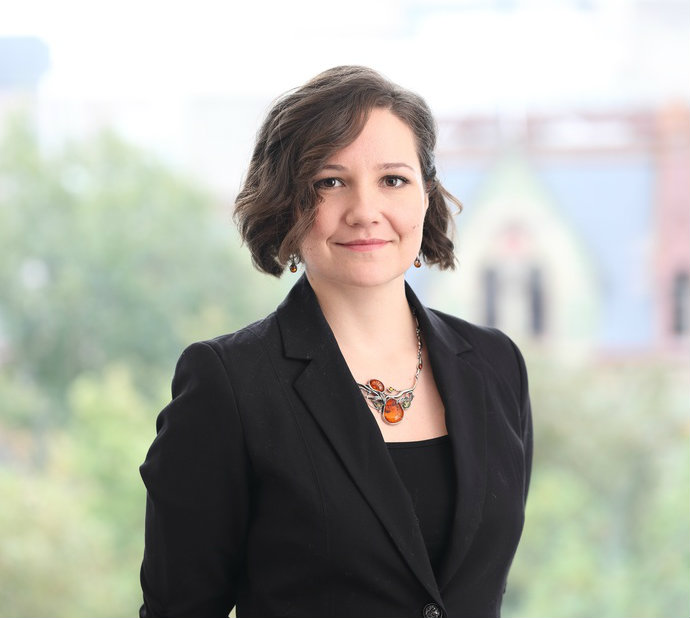Examining Genocide Through Scholarship and Art
Criminology master's student Sarah Jewett uses statistical and empirical analysis and computer programming to study war crimes.
Ever since she first learned about the Holocaust, graduate student Sarah Jewett has been trying to understand how such a thing could happen. Although none of her family members were directly affected by the event, she could not put it out of her mind.
“I felt baffled by it,” she says. “I wanted to understand what could make people do those sorts of things. I started reading about psychology and mass murder.”
Trained in fine arts, Jewett also began to explore the topic of human rights in haunting portraits of victims of genocide, slavery, and human trafficking. But a disturbing encounter with a viewer at an exhibition prompted a career shift. “A woman saw one of my pieces and said something very anti-Semitic, and I realized there’s a certain responsibility in creating art with this topic, and I felt that while I knew a lot, I probably didn’t know as much as I could.”
She decided to earn a master’s degree in Holocaust and Genocide Studies from West Chester University. She then enrolled in Penn’s one-year master’s program in criminology, in part to acquire skills in statistical and empirical analysis and computer programming. “Criminology has a largely untapped potential in genocide research, particularly where perpetrators are concerned,” says Jewett. “Genocide is, after all, a crime, and many criminological theories are well suited for understanding its perpetration.”
Jewett initially focused on trying to glean a consensus from the multi-disciplinary and relatively new field of genocide studies. So far, she has organized the mechanisms of genocide under six categories: cognitive dissonance (when an individual’s actions are in conflict with his or her beliefs); victim degradation (recategorization, dehumanization, trivialization, devaluation, scapegoating, just-world thinking); perpetrator defenses (justification, victimization, rationalization, repression, denial, humor); normalcy (division of labor, routinization, desensitization, acclimatization); authority (authorization, authoritarian personality, obedience to authority); and language (euphemism, dysphemism).
Her current research examines whether perpetrator age influences sentencing in the International Criminal Tribunal for the former Yugoslavia, looking for correlations between age and remorse, as well as whether remorse impacts sentencing.
Driving all of her work is a determination to understand the process of genocide from beginning to end. “Scholars generally see dehumanization of victims as a first step in genocide,” says Jewett. “I think there is also a tendency to dehumanize the perpetrators—people don’t want to identify with somebody who’s capable of participating in mass murder, and so you get terminology like, ‘They’re a monster.’ People separate the perpetrator from humanity as well.”
She stresses the importance of recognizing that all people have the capacity to commit terrible acts, citing Christopher Browning’s 1992 book, Ordinary Men, which looked at members of the German “Order Police,” who carried out massacres of Jews in German-occupied Poland and who largely justified their actions as following orders.
The victimization narrative is another key concept to understand. “It’s when like-minded people have an idea of wanting to get rid of a problem,” Jewett says. “Perpetrators say of their victims, ‘They hurt us first. They’re the reason why we’re suffering.’”
Ultimately, her research aims to help foster awareness in an effort to reduce the risk of future genocides. “For me, the bottom line is that we have to recognize this capability within ourselves and we have to stay vigilant,” she says. “Discrimination and prejudice exist in every society, and genocide is an extreme manifestation of bigotry.”
Immersing oneself in the dark side of humanity can be a painful and even traumatic endeavor, and Jewett has had disturbing dreams and works to keep pessimism at bay. She continues to make art and feels driven to make a difference by learning and communicating the lessons of genocide theory.
“I have this intense focus on public dissemination of these lessons,” she says. “With my art, it’s the same—applying beauty to what are otherwise difficult topics, to allow people to investigate them perhaps with greater ease. Not just for prevention of genocide. It really has to do, I think, with overall humanity. How can we treat each other better? How can we recognize what we are capable of? One thing I want to convey is that we do have control. You can walk away, you can say no. You don’t have to be manipulated by somebody else’s agenda into becoming a worse version of yourself.”



